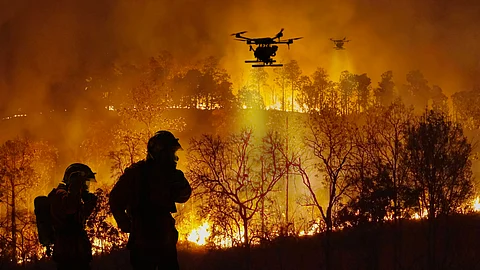

At least 18 people lost their lives and 19 others have been injured as wildfires continue to devastate South Korea’s southeastern regions, according to the latest figures released by the Ministry of the Interior and Safety.
Acting President Han Duck-soo described the situation as an unprecedented crisis, stating that the fires are ‘rewriting the record books for the worst wildfires in our nation’s history’.
The fires initially erupted on March 21 in Sancheong County before spreading to neighbouring areas, including Uiseong, Andong, Cheongsong, Yeongyang and Yeongdeok.
More than 23,000 residents have been forced to evacuate, with several cultural heritage sites suffering damage — including a 1,300-year-old Buddhist temple that has been completely destroyed.
In its latest update from ground zero, BBC reported today on March 26, that a firefighting helicopter crashed in the mountainous area of Uiseong County shortly, with an investigation underway to determine the cause.
Thousands of firefighters and approximately 5,000 military personnel have been mobilised to battle the multiple blazes, alongside helicopters from the US military stationed in South Korea.
Yesterday, on March 25, the National Fire Agency designated the crisis to the highest emergency response level — the first time such a measure has been taken this year.
Forest fires are relatively rare on the Korean Peninsula whose serene mornings have earned it the epithet of the ‘land of the morning calm’.
This makes the current outbreak as the deadliest in the country’s history, with 18 fatalities recorded in just a few days.
Around 17,000 hectares of forest have been consumed by the flames, making this the third-largest wildfire in terms of area in South Korea’s records.
Among the losses is the historic Gounsa Temple, constructed in 618 AD, one of the largest temples in the region. Forestry officials also confirmed the destruction of a Buddhist structure which is hailed as a national treasure and dates back to the reign of the Joseon Dynasty (1392-1910).
Acting President Han told BBC that all available resources have been deployed, but strong winds continue to hinder firefighting efforts.
“We had hoped for rain today or tomorrow to help control the fires, but conditions remain challenging," he said, adding, “The scale of destruction is unlike anything we’ve seen before”.
The Korea Meteorological Administration reported no rainfall expected today, with only 5-10mm forecast for Thursday — far from sufficient to douse the flames.
Han pledged that once the crisis is under control, the government will conduct a full review of response efforts and strengthen future wildfire prevention measures.
“Once a wildfire ignites, suppressing it demands immense resources and endangers lives,” he emphasised.
South Korea has faced drier-than-usual conditions this year, with below-average rainfall. Already, 244 wildfires have been recorded — 2.4 times more than during the same period last year.
Authorities have vowed to tighten penalties for illegal burning, a major cause of wildfires and crack down on negligence to prevent future disasters.
Meanwhile, South America, which has been in the summer solstice until now, also remains in the grip of devastating wildfires as extreme heat and drought conditions continue to fuel the crisis, with Argentina and Chile bearing the brunt of the destruction.
In Chile, officials reported 74 separate wildfires during late January, with emergency teams working tirelessly to bring the situation under control.
In the rescue efforts, three firefighters lost their lives while battling flames in the Araucanía region.
Meanwhile in Argentina, the picturesque Comarca Andina region of Patagonia has suffered catastrophic damage, with vast swathes of its unique agricultural and forested landscapes consumed by fire.
The scale of destruction continues to mount, with preliminary estimates suggesting over 35,000 hectares have already been reduced to ashes.
The fires have not only devastated natural habitats but also destroyed homes, claimed livestock and displaced hundreds of residents. A particularly grim milestone was reached when one local resident perished while attempting to escape the advancing flames.
Firefighting efforts face immense challenges due to a dangerous concoction of factors. Strong winds have repeatedly reignited contained areas while pushing flames into new territory and unrelenting summer temperatures have created tinder-dry conditions across the region. The situation has grown increasingly precarious with new outbreaks reported along the eastern Andean slopes, stretching already overwhelmed emergency services to their limits.
To make things worse, meteorological forecasts offer little hope for immediate relief, with no meaningful rainfall predicted in the coming days.
The ongoing crisis has reignited discussions about climate change's role in intensifying wildfire seasons, as scientists note the increasing frequency and severity of such events across South America. Authorities in both countries have warned residents to remain vigilant as the region faces what may become one of its most destructive fire seasons on record.